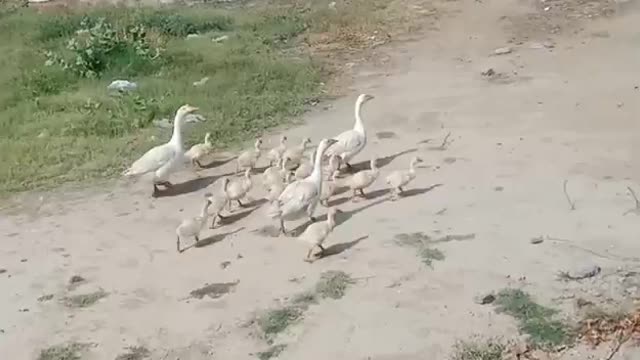Premium Only Content

Duck and his family walking on ground and their children looking pretty| #duckfamily
Duck Facts and Worksheets
Ducks are birds and are commonly known as waterfowl because they spend so much time around places with water. They are found everywhere in the world except Antarctica where it is too cold for them.
Ducks are birds and are commonly known as “waterfowl” because they spend so much time in places with water. They love water! They are found everywhere in the world except Antarctica where it is too cold for them. Keep reading for some interesting facts on ducks below.
Ducks are birds that are also called “waterfowls” because they are normally found in places with water like marshes, oceans, rivers, ponds, and lakes. This is because ducks love the water.
Ducks can live from 2-12 years, depending on species.
Some species of ducks migrate or travel long distances every year to breed. Usually they travel to warmer areas or where the water does not freeze so that they can rest and raise their young. The distance may be thousands of miles away.
Ducks are found everywhere in the world except the Antarctica which is too cold for them.
Ducks are related to geese and swans, but the duck is the smallest of them all.
Ducks have shorter necks and wings than other waterfowl, and they also have a stout body. Ducks of different species look different.
Some ducks are very colorful like the Perching ducks. Usually, the males or drakes are usually the brightly colored ones while the females (ducks) are usually dull-colored and brown in color so that they can hide and camouflage from their enemies when they are in their nests.
Ducks have webbed feet that are designed for swimming. Their webbed feet act like paddles and they waddle instead of walk because of their feet. The duck’s feet cannot feel cold even if it swims in icy cold water because their feet have no nerves or blood vessels.
The duck has water-proof feathers. A special gland that produces oil is located near the duck’s tail. This oil spreads and covers the outer coat of the duck’s feathers, making it water-proof. Beneath the water-proof feathers are fluffy and soft feathers that keep the duck warm.
Ducks keep their feathers clean by preening. They do this by putting their heads in funny positions and putting their beaks into their body. They preen themselves very often.
Most ducks quack, however, the wood duck squeals. The duck’s mouth is called a “bill”. However, ducks bills come in different shapes and sizes. The shape of the bill and body features will determine how the duck hunt for its food.
Ducks usually look for a mate in winter. The males will attract the females with their colorful plumage or feathers. Once the female lays 5-12 eggs, she will start to sit on her eggs to keep it warm so that they can hatch into ducklings. The males on the other hand, will be with the other males.
The eggs of most ducks will hatch within 28 days. The mother duck will keep her ducklings together to protect them from predators. Animals like the hawk, snakes, raccoon, turtles, and large fish will eat the ducklings.
Ducklings are able to fly within 5-8 weeks. The production of eggs are affected by daylight. When there is more daylight, the ducks will lay more eggs.
In the months of July to December when daylight is short, ducks slow down their production of eggs. Sometimes, they stop laying eggs completely during these months. To prevent this from happening, farmers use artificial lighting so that the ducks have about 17 hours of light a day to produce eggs efficiently.
Duck Worksheets
This comprehensive guide to your study of Ducks is an incredible addition to any science class. It is packed with over 19 pages of facts, information and trivia focusing on characteristics of Ducks and key features of this wonderful Animal. This is an excellent addition to your studies and will help you understand everything you need to about Ducks and the different types of Duck species. Download today!
Download the study guide to learn more about Ducks of which are commonly known as Waterfowl for their love of water. Use it in the classroom perhaps when studying animals and animal habitats or at home for further revision.The worksheet includes challenging activities to really test the knowledge gained on the study of Ducks and different species of Ducks across the world.
-
 11:45:14
11:45:14
Right Side Broadcasting Network
9 days agoLIVE REPLAY: TPUSA's America Fest Conference: Day Three - 12/21/24
336K28 -
 12:19
12:19
Tundra Tactical
14 hours ago $12.74 earnedDaniel Penny Beats Charges in NYC Subway Killing
60K12 -
 29:53
29:53
MYLUNCHBREAK CHANNEL PAGE
1 day agoUnder The Necropolis - Pt 1
153K51 -
 2:00:10
2:00:10
Bare Knuckle Fighting Championship
3 days agoCountdown to BKFC on DAZN HOLLYWOOD & FREE LIVE FIGHTS!
55.7K3 -
 2:53:01
2:53:01
Jewels Jones Live ®
1 day agoA MAGA-NIFICENT YEAR | A Political Rendezvous - Ep. 103
148K36 -
 29:54
29:54
Michael Franzese
17 hours agoCan Trump accomplish everything he promised? Piers Morgan Article Breakdown
134K56 -
 2:08:19
2:08:19
Tactical Advisor
21 hours agoThe Vault Room Podcast 006 | Farwell 2024 New Plans for 2025
198K11 -
 34:12
34:12
inspirePlay
1 day ago $6.00 earned🏆 The Grid Championship 2024 – Cass Meyer vs. Kelly Rudney | Epic Battle for Long Drive Glory!
95.7K8 -
 17:50
17:50
BlackDiamondGunsandGear
19 hours ago $3.37 earnedTeach Me How to Build an AR-15
69.3K6 -
 9:11
9:11
Space Ice
1 day agoFatman - Greatest Santa Claus Fighting Hitmen Movie Of Mel Gibson's Career - Best Movie Ever
125K50